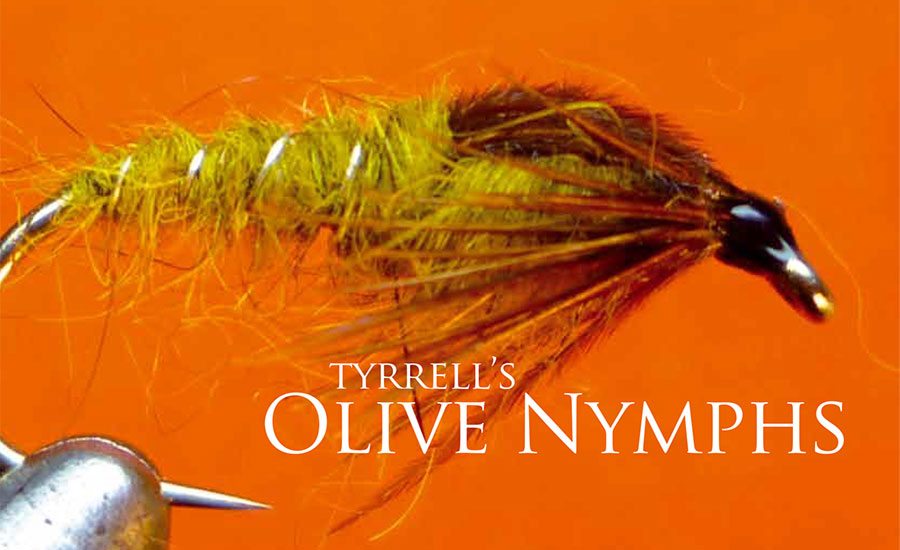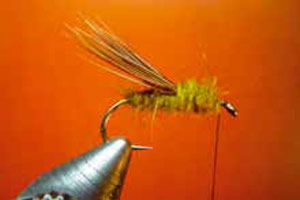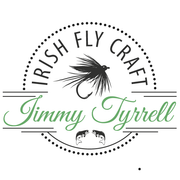Tyrrell’s Olive Nymphs - Irish Angler Magazine March 2010
- by Irish Fly Craft Admin
-

If the olives aren’t hatching, there’s nothing Jimmy Tyrrell likes more than some early season nymphing. This is a pattern that has brought him a lot of success.
I really look forward to the start of the fishing season on my local rivers and doing a bit of nymph fishing. Unless, that is, we have a very mild opening and we get good hatches of olives, something I haven’t seen happen for quite a number of years. I have had some fantastic sport with this nymph even in the coldest weather when only the foolhardy would venture out with a fly rod. I really enjoy this type of fishing as it can be done right through the season, especially on those days when nothing is happening and the fish are lying low.
There can be fantastic sport at this time of year and you can learn an awful lot by studying where the good fish lies are and just by looking at the type of water that you have caught any fish in. I’m not into big, heavy nymphs, preferring something that is a bit more natural looking. I still like to weight the nymphs that I tie, but only enough to get the fly through the surface as I don’t like the nymph to sink too fast.
I like to fish these nymphs in the faster, streamier stretches of the river working them into the slower pools where you would hope there are going to be some nice fish lying there waiting for food to be washed into the pool. These are the kind of places where the bigger fish tend to lie as they are not using up to much energy and the food is being washed in to them on a conveyor belt.
"I’m not into big, heavy nymphs, preferring something that is a bit more natural looking."
I am going to show you a nymph pattern that has given me very good fishing at the start of the season for quite a number of years and right through the season. I tie quite a lot of these for people and I have not had any bad feedback yet.
The Olive Nymph is a big favourite of mine. You can change the colours to produce the Dark or Light Olive Nymph. These olive nymphs are fairly straightforward to tie as there is very little material required, just hare or rabbit fur, cock pheasant tail and some wire for the rib. For the first fly, which is my tying for the Olive Nymph, I like to use the fur from a hare’s mask. I take fur from different parts of the mask and mix it together with the darker hair fibres from the ears.
Hare’s fur from the mask dyed olive, mixed together with fibres from the ears is really a fantastic natural material that gives the fly that bit more life. I use this in a lot of fly patterns. I prefer to use olive hare’s fur for the body and thorax of this fly, but any olive fur will do. Even fine seal’s fur will do as long as the fly is not to bulky and tied with a nice tapered shape to imitate the insect.
At the start of the season I normally add a small amount of lead wire under the thorax if the water is high and fast, but not too much as you only want to fish the fly just off the river bed. If you weight this fly with about three to four turns of fine lead wire positioned under the thorax about three-quarters of the way up the hook shank this will get the fly down to where the trout are feeding. In the main there is very little fly life on the surface of the river at this time of year. If you give the line a slight twitch with you finger to give the fly that bit of life as if it were trying to get to the surface.
"I like to tie most of my nymphs so that the tips of the cock pheasant tail covering the thorax act as legs."
I like to tie most of my nymphs so that the tips of the cock pheasant tail which is covering the thorax act as legs when you pull them over the thorax and tie them down. This gives the nymph that life-like appearance when fished just off the river bed it also gives the fly movement in the water.
Again this is one of those flies that can represent a number of different insects. I sometimes like to put a rib of pearl flash on the body just as an attracter. You can also use silver wire, or use both as the pearl flash rib tends to gets a bit battered after a few takes but still gives added attraction. I tie this pattern in a number of different colours and sizes, especially natural hare’s fur with a gold rib.
If I am going to fish with two flies on the one cast I would normally weight the olive nymph and put this on the point and fish a spider pattern on the dropper. The weighted nymph gets the spider pattern down under the surface straight away so that you don’t create any drag and it is important that you keep in contact with the fly as you must strike at any movement.
I hope you will have as much good sport as I have had with this pattern. Sometimes the simpler the fly the better.
Tyrrell's Light Olive Nymph
| Hook: | Standard 12 or 14 down eye |
| Rib: | Pearl flash, fine silver wire or flat tinsel |
| Body: | Fur from a hare’s mask, or rabbit fur, colours from light and dark olive |
| Wing Case: | Strands of cock pheasant tail |
| Thorax: | Same as the body |
Tying Instructions
 Step One: Wind on a few turns of lead wire.
Step One: Wind on a few turns of lead wire. Step Two: Secure the led with tying thread, finishing at the bend of the hook.
Step Two: Secure the led with tying thread, finishing at the bend of the hook. Step Three: Tie in a strand of silver wire or pearl flash or both.
Step Three: Tie in a strand of silver wire or pearl flash or both. Step Four: Dub some fur onto the tying thread.
Step Four: Dub some fur onto the tying thread. Step Five: Wind on the dubbing in a nice tapered shape, follow with the rib and tie off.
Step Five: Wind on the dubbing in a nice tapered shape, follow with the rib and tie off. Step Six: Catch in about a dozen fibres of cock pheasant tail fibres.
Step Six: Catch in about a dozen fibres of cock pheasant tail fibres. Step Seven: Build up the thorax with more dubbing fur.
Step Seven: Build up the thorax with more dubbing fur. Step Eight: Pull the cock pheasant fibres forward, trap down and divide to form the legs.
Step Eight: Pull the cock pheasant fibres forward, trap down and divide to form the legs. Step Nine: Stroke the cock pheasant fibres back down and under, tie down, whip finish and varnish.
Step Nine: Stroke the cock pheasant fibres back down and under, tie down, whip finish and varnish.Tying Tips
Tip 1: Make the body a nice tapered shape, starting on the bend of the hook.
TIP 2: Don’t tie in too many cock pheasant tail fibres – about a dozen is plenty.
TIP 3: When you fold under the pheasant tail for the legs don’t let them pass any further than the hook point.





